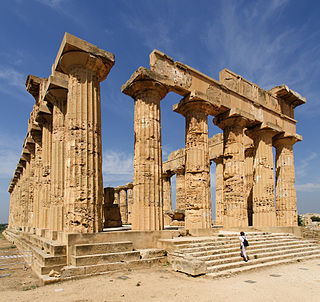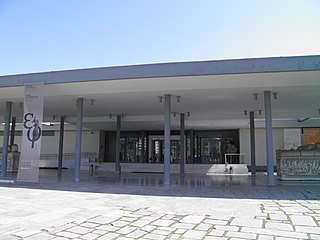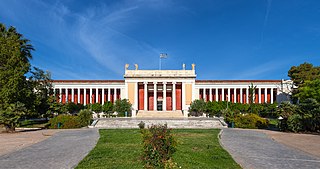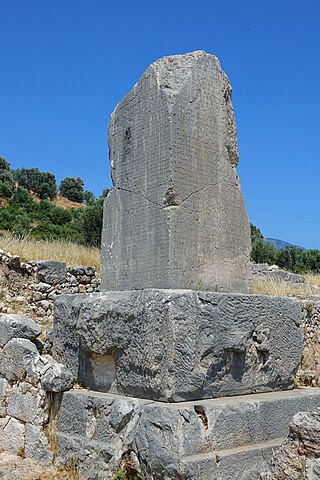
Selinunte was a rich and extensive ancient Greek city of Magna Graecia on the south-western coast of Sicily in Italy. It was situated between the valleys of the Cottone and Modione rivers. It now lies in the comune of Castelvetrano, between the frazioni of Triscina di Selinunte in the west and Marinella di Selinunte in the east.

The Archaeological Museum of Thessaloniki is a museum in Thessaloniki, Central Macedonia, Greece. It holds and interprets artifacts from the Prehistoric, Archaic, Classical, Hellenistic and Roman periods, mostly from the city of Thessaloniki but also from the region of Macedonia in general.

The National Archaeological Museum in Athens houses some of the most important artifacts from a variety of archaeological locations around Greece from prehistory to late antiquity. It is considered one of the greatest museums in the world and contains the richest collection of Greek Antiquity artifacts worldwide. It is situated in the Exarcheia area in central Athens between Epirus Street, Bouboulinas Street and Tositsas Street while its entrance is on the Patission Street adjacent to the historical building of the Athens Polytechnic university.

Kamarina or Camarina was an ancient city on the southern coast of Sicily in Magna Graecia. The ruins of the site and an archaeological museum are located south of the modern town of Scoglitti, a frazione (borough) of the comune (municipality) of Vittoria in the province of Ragusa.

The Staatliche Antikensammlungen is a museum in Munich's Kunstareal holding Bavaria's collections of antiquities from Greece, Etruria and Rome, though the sculpture collection is located in the Glyptothek opposite, and works created in Bavaria are on display in a separate museum. Ancient Egypt also has its own museum.

The Archaeological Museum of Corfu in Corfu, Greece was built between 1962 and 1965. The museum land was donated by the city of Corfu. Its initial purpose was to house the archaeological finds from the Temple of Artemis in Corfu. In 1994 it was expanded with the addition of two more exhibit halls that display the more recent finds at the ancient citadel of Corfu. It is located on 1 Vraila Armeni St.

Delphi Archaeological museum is one of the principal museums of Greece and one of the most visited. It is operated by the Greek Ministry of Culture. Founded in 1903, it has been rearranged several times and houses the discoveries made at the Panhellenic sanctuary of Delphi, which date from the Late Helladic (Mycenean) period to the early Byzantine era.

The Temple of Hera, or Heraion, is an ancient Archaic Greek temple at Olympia, Greece, that was dedicated to Hera, queen of the Greek gods. It was the oldest temple at Olympia and one of the most venerable in all Greece. It was originally a joint temple of Hera and Zeus, chief of the gods, until a separate temple was built for him. It is at the altar of this temple, which is oriented east-west, that the Olympic flame is lit and carried to all parts of the world. The torch of the Olympic flame is lit in its ruins to this day. The temple was built in approximately 590 BC, but was destroyed by an earthquake in the early 4th century AD.

The Archeological Museum of Eleusis is a museum in Eleusis, Attica, Greece. The museum is located inside the archaeological site of Eleusis. Built in 1890, by the plans of the German architect Kaverau, to keep the findings of the excavations, and after two years (1892) was extended under the plans of the Greek architect J. Mousis.

The Archaeological Museum of Aegina is a museum in Aegina, Greece, founded on 21 October 1828 by Ioannis Kapodistrias, the first governor of independent Greece.

The Archaeological Museum of Delos is a museum on the island of Delos, near Mykonos in the South Aegean, Greece. It is noted for its extensive collection of statues unearthed in the surrounding area of the ancient site, which has been declared a UNESCO World Heritage Site. Although the museum has a considerable collection, it does not contain all of the items found in Delos: a large quantity are on display in Athens at the National Archaeological Museum.

The Museum of Fine Arts of Lyon is a municipal museum of fine arts in the French city of Lyon. Located near the Place des Terreaux, it is housed in a former Benedictine convent which was active during the 17th and 18th centuries. It was restored between 1988, and 1998, remaining open to visitors throughout this time despite the ongoing restoration works. Its collections range from ancient Egyptian antiquities to the Modern art period, making the museum one of the most important in Europe. It also hosts important exhibitions of art, for example the exhibitions of works by Georges Braque and Henri Laurens in the second half of 2005, and another on the work of Théodore Géricault from April to July 2006. It is one of the largest art museums in France.
The Extramural Sanctuary of Demeter and Persephone at Cyrene, Libya is located on a coastal plateau of Libya, beyond the boundaries of the city (extramural). In approximately 630 BC Greeks from the island of Thera colonized Cyrene. Other Greek colonists not long after increased the population, thus transforming Cyrene into what was regarded as both the largest and wealthiest Greek colony of North Africa. Archaeological excavations of Cyrene's Extramural Sanctuary of Demeter and Persephone, also known as Kore, daughter of Demeter and legendary Queen of the Underworld and consort of Hades, began in 1969 under the sponsorship of the University of Michigan. Between 1973 and 1981 the University of Pennsylvania Museum of Archeology and Anthropology continued the excavations at Cyrene under the direction of Professor Donald White. Following the renewal of relations between Libya and the United States in 2004, the Cyrenaica Archaeological Project (CAP), under the direction of Professor Susan Kane of Oberlin College, was granted permission to resume the work of its predecessors.

The Antonino Salinas Regional Archeological Museum is a museum in Palermo, Italy. It possesses one of the richest collections of Punic and Ancient Greek art in Italy, as well as many items related to the history of Sicily. Formerly the property of the Oratory of Saint Philip Neri, the museum is named after Antonino Salinas, a famous archaeologist and numismatist from Palermo who had served as its director from 1873 until his death in 1914, upon which he left it his major private collection. It is part of the Olivella monumental complex, which includes the Church of Sant'Ignazio all'Olivella and the adjoining Oratory.

Ancient Greek art stands out among that of other ancient cultures for its development of naturalistic but idealized depictions of the human body, in which largely nude male figures were generally the focus of innovation. The rate of stylistic development between about 750 and 300 BC was remarkable by ancient standards, and in surviving works is best seen in sculpture. There were important innovations in painting, which have to be essentially reconstructed due to the lack of original survivals of quality, other than the distinct field of painted pottery.

Ocriticum was an Italic and Roman town, the ruins of which are located in the comune of Cansano, in the province of L'Aquila in the Abruzzo region of Italy.

The theme of death within ancient Greek art has continued from the Early Bronze Age all the way through to the Hellenistic period. The Greeks used architecture, pottery, and funerary objects as different mediums through which to portray death. These depictions include mythical deaths, deaths of historical figures, and commemorations of those who died in war. This page includes various examples of the different types of mediums in which death is presented in Greek art.

Ancient Greek funerary vases are decorative grave markers made in ancient Greece that were designed to resemble liquid-holding vessels. These decorated vases were placed on grave sites as a mark of elite status. There are many types of funerary vases, such as amphorae, kraters, oinochoe, and kylix cups, among others. One famous example is the Dipylon amphora. Every-day vases were often not painted, but wealthy Greeks could afford luxuriously painted ones. Funerary vases on male graves might have themes of military prowess, or athletics. However, allusions to death in Greek tragedies was a popular motif. Famous centers of vase styles include Corinth, Lakonia, Ionia, South Italy, and Athens.
The Sanctuary of Demeter and Kore was a sanctuary in ancient Syracuse in Sicily, Magna Graecia, dedicated to Demeter and Kore (Persephone).

The Lapidary Museum is a lapidarium-museum in Avignon, France. It has housed the classical Greek, Etruscan, Roman and Gallo-Roman sculptures and objects of the Calvet Museum since the 1980s. They are both run by the Fondation Calvet. As well as exhibiting the museum's core collections, it also mounts summer temporary exhibitions, conferences and networking events, particularly for scholars.



















